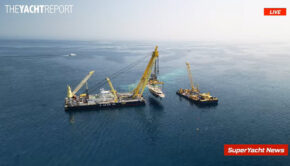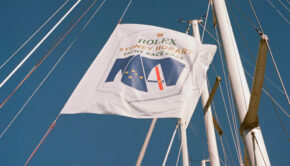Did anchor sway contribute to Bayesian tragedy?
Published on August 29th, 2024
The sinking and seven deaths on the 56m Perini Navi Bayesian has garnered international attention, and while a formal investigation is underway to determine the events that led to the incident, expert observers have shared their experience. Professional captain Rudy Puister leans in with a new theory:
In reading all news articles about this disaster, and with special interest from a professional background into the causes that led to the rapid sinking of the Bayesian, I have not seen any mention of the fact a sailing boat at (single) anchor starts swaying behind its chain.
At maritime college, it’s taught that ships with their wind center forward of the lateral center of resistance from the hull, start swaying behind its chain. The higher the wind, the more extreme this swaying becomes, resulting in the vessel starting to build up speed in the water behind its chain.
For a sailing vessel built to cruise with winds from a beam could easily start to run into the direction of its anchor, therefore creating slack… until it runs in its chain again. What happens next is that either the anchor start dragging, or the chain breaks when the vessel reaches the end of the chain.
This is one of the main reasons anchors drag or chains break that result in ship accidents, groundings, and disasters since humans started exploring the seas.
One simple remedy against this effect is deploying a second anchor in the opposite direction of the vessels first anchor so the vessel in effect becomes in the center of the two-chain spread. Another remedy is to deploy its second anchor (or any other heavy weight dragging over the bottom) to stop the motion of the sway and the resulting speed build-up.
Sailing yachts are especially vulnerable to the swaying behind it’s anchor and a big hazard at anchor in high winds and populated anchor grounds.
Sudden storms make many yachts swaying in each other’s anchor zones with collisions or crew frantically trying to avoid such. In trying to steer free of each other, not seldom increasing the build-up speeds, this results in dragging anchors or breaking chains…. YouTube is full of videos of such events.
But what if the anchor chain doesn’t break? Or the anchor doesn’t drag!
A big yacht, particularly a long one with a high rigging as the Bayesian, would relatively easily build up a high swaying speed, especially when the crew put out some extra chain length in anticipation of some foul weather, resulting into possibly several knots of speed before the ship runs into the end of the chain.
Since the wind was already strong for minutes, long enough to have the speedy swaying to start, and some of the survivors stated the vessel already listed (due the wind) before it suddenly heeled a lot more and sank, makes me believe the last push that made the ship go flat in the water (90 degrees) was the running of the vessel with high speed into its anchor chain.
This brute force of the sudden pull of the anchor chain (and not braking!) abeam, on the bow, would in itself already be enough to give a sailing vessel a considerable list.
Combined with the very tall mast, the extreme wind, and a reduced CPG (Centre Point of Gravity) due the possible retracted keel (which probably wouldn’t have saved here if it was deployed), these combined dynamic forces would have been enough to push the ship 90 to 100 degrees in the water in a rapid movement leaving no other result of the imminent flooding and sinking of the yacht.
I don’t know if the Bayesian was equipped with a second anchor and chain, and if so, deployed. But if it didn’t have one, like most yachts, or it wasn’t deployed, then I’ll bet this was the cause of the tragedy.
It’s sad but disasters like this are to be studied and investigated to learn and prevent similar accidents to happen ever again. But any ‘old school’ sailor could have prevented the tragedy if he/she would have had the liberty (and option) to take the measurements and efforts to deploy a storm safe anchor rigging.
Investigators and divers have to investigate into the state of the anchor (did it drag or did it hold) and chain (broken or still intact) and maybe look for signs the anchor rigging was exposed to excessive forces.
I am curious why the experts and commenters haven’t mentioned this effect, as it’s pretty common in shipping and the cause of many past ship disasters.









 We’ll keep your information safe.
We’ll keep your information safe.